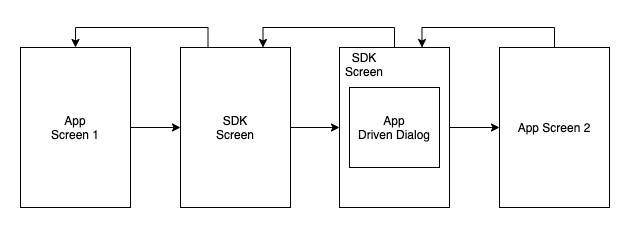You will not surprise anyone with a single activity approach when creating a final application for Android. But we went further and used No-Activity when developing the SDK. Now let's figure out why it was needed, the difficulties encountered and how they were solved.
Standard 3rd party SDKs in Android
How do external SDKs usually work in Android? Open Activitylibrary, performed some work, the result is returned if necessaryonActivityResult.

, SDK . SDK, :

, SDK . , , , MapFragment Google. , , .
SDK
SDK , -
ActivitySDK -., SDK. (: , ).
SDK Lock Screen. , Lock
Activity.
No-Activity SDK
, , , (Activity) SDK . - SDK . .

, . ?
No-Activity SDK
SDK , .. .
, SDK -
childFragmentManager., .. .
No-ActivitySDK
, Single-Activity.
SDK , dagger - ( ).
SDK
Activity..requireActivity. SDK.ActivityonActivityResult, , , .SDK, ..
Activity.
3rd party SDK
SDK. . , dagger2 .
Dagger2 SDK
dagger Application. SDK , Application, , .
, .
internal object ComponentHolder {
lateinit var appComponent: SdkAppComponent
private set
@Synchronized
fun init(ctx: Context) {
if (this::appComponent.isInitialized) return
appComponent = DaggerSdkAppComponent
.builder()
.sdkAppModule(SdkAppModule(ctx))
.build()
}
} , init, , SDK , . SDK. EntryPointFragment. SDK. SDK childFragmentManager.
EntryPointFragment ComponentHolder Dagger.
override fun onCreate(savedInstanceState: Bundle?) {
ComponentHolder.init(requireActivity())
ComponentHolder.appComponent.inject(this)
super.onCreate(savedInstanceState)
}, ComponentHolder, SDK .
okhttp3 major 4.+. Kotlin, , , code() . SDK, 3, 4 SDK, .
, . 2 flavor:
flavorDimensions("okhttpVersion")
productFlavors {
v3 {
dimension = "okhttpVersion"
}
v4 {
dimension = "okhttpVersion"
}
}
dependencies {
v3Api okhttp3.core
v3Api okhttp3.logging
v4Api okhttp4.core
v4Api okhttp4.logging
} , flavor , code() code.
// Code in v3 folder
class ResponseWrapper(private val response: Response) {
val code : Int
get() = response.code()
}// Code in v4 folder
class ResponseWrapper(private val response: Response) {
val code : Int
get() = response.code
}.
: , :
defaultConfig {
...
missingDimensionStrategy 'okhttpVersion', 'v4'
}In this case, you get rid of the build conflict. Otherwise, there simply won't be a version.
Conclusion
SDK development, when compared to a simple Android application, is much more difficult, but sometimes more interesting. Also, the requirements for the quality of the final product are higher - if something falls, it will not fall for you, but for your client, which is very bad.